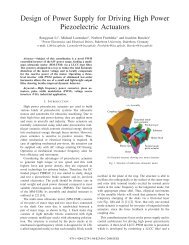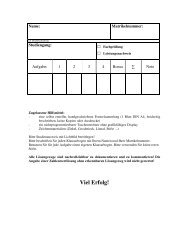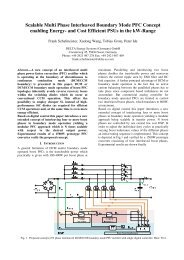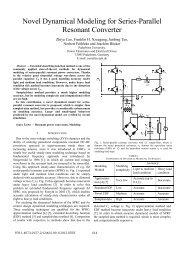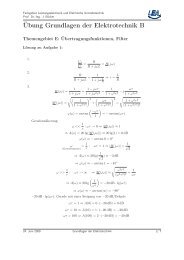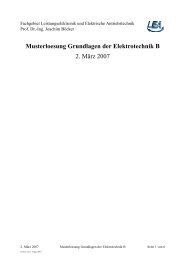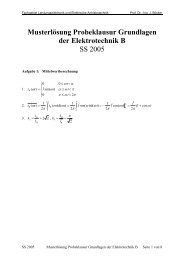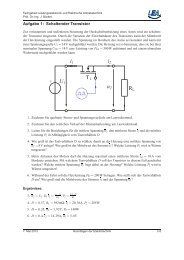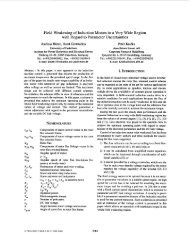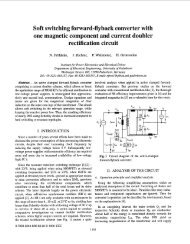Organization and Control of Autonomous Railway Convoys
Organization and Control of Autonomous Railway Convoys
Organization and Control of Autonomous Railway Convoys
Create successful ePaper yourself
Turn your PDF publications into a flip-book with our unique Google optimized e-Paper software.
AVEC ’08<strong>Organization</strong> <strong>and</strong> <strong>Control</strong> <strong>of</strong> <strong>Autonomous</strong> <strong>Railway</strong> <strong>Convoys</strong>Christian Henke*, Matthias Tichy, Tobias Schneider, Joachim Böcker, Wilhelm SchäferUniversity <strong>of</strong> PaderbornWarburger Str. 100, 33098 Paderborn, Germany*Phone +49-5251-60-5482*Facsimile +49-5251-60-3443E-mail: henke@lea.upb.deSubject <strong>of</strong> the RailCab project is the development <strong>of</strong> autonomous railway vehicles which c<strong>and</strong>ynamically group to convoys without mechanical coupling. This enables an on-dem<strong>and</strong> use <strong>of</strong>these vehicles while retaining the cost <strong>and</strong> ecological advantages <strong>of</strong> public transport. In this paper,we present (1) the convoy communication with respect to joining <strong>and</strong> leaving a convoy as well as(2) the convoy control strategy. We strongly emphasize the safety <strong>of</strong> the developed s<strong>of</strong>tware.Topics: Intelligent Transportation System, Vehicle <strong>Control</strong>1. INTRODUCTIONIn terms <strong>of</strong> ecological values, public transport bybus or railway is deemed superior to individual transportby car. Unfortunately, today’s public transport cannotkeep up with individual transport in terms <strong>of</strong> flexibility<strong>and</strong> comfort. The RailCab project was founded at theUniversity <strong>of</strong> Paderborn in 1998 in order to develop anew railway system that features the advantages <strong>of</strong> bothtechniques in terms <strong>of</strong> cost <strong>and</strong> energy efficiency aswell as flexibility <strong>and</strong> comfort [1].The novel system is characterized by smallautonomous vehicles traveling on dem<strong>and</strong> instead <strong>of</strong>trains operating on a fixed schedule. For real-lifevalidation <strong>of</strong> the complex mechatronic system, a testtrack in a scale <strong>of</strong> 1:2.5 was built at the University <strong>of</strong>Paderborn in 2002. The rail vehicles, so-called RailCabs,can align with others without mechanical coupling [2].Best energy saving is achieved with distances betweenthe RailCabs below a meter.The employed motor, a doubly-fed linear motor [3]enables relative motion between vehicles cruising on thesame stator section. Thus, it is possible to merge <strong>and</strong>split convoys while driving. Furthermore, the activesteering allows grouping <strong>of</strong> convoys at passive trackswitches. Consequently, dynamic convoy driving ispossible which <strong>of</strong>fers the following possibilities:• Increasing the track capacity• Decreasing the energy consumptionIn the past, most <strong>of</strong> the research activities about thecontrol <strong>of</strong> vehicle platoons dealt with automotiveapplications <strong>and</strong> discussed the problem <strong>of</strong> nonlinearvehicle models. [4], [5] described the influence <strong>of</strong> thecommunication topology on convoy stability. In case <strong>of</strong>very small distances, a communication <strong>of</strong> lead vehicleinformation is m<strong>and</strong>atory. Otherwise driving withinsmall distances cannot be h<strong>and</strong>led. Several controllerdesigns ensuring safety are presented in [6]. Thedifferent controller designs are chosen depending on thecurrent driving mode. They also include lane changes<strong>and</strong> lateral control.However, in case <strong>of</strong> rail-bound vehicles, only thecontrol <strong>of</strong> the longitudinal dynamics is required withrespect to drive control. The mentioned linear motorprovides constant thrust in the operating range.Consequently, in contrast to road traffic, an advancedconvoy control strategy allows safe driving with smalldistances between vehicles. We employ a singlecontroller design <strong>and</strong> distinguish the different operatingmodes by adapting reference values.The crucial point for the control <strong>of</strong> longitudinaldynamics <strong>and</strong> distance control is the reference generator,which must include limitations <strong>of</strong> speed, acceleration<strong>and</strong> jerk. The adherence to these limitations has to beensured for all vehicles involved in a convoy.Therefore, the individual limits <strong>of</strong> each vehicle arecommunicated to a vehicle which coordinates theconvoy. This vehicle computes the limits for the wholeconvoy <strong>and</strong> sends them back to all vehicles. Thereafter,the vehicles are allowed to build a convoy under thecondition that they respect the communicated limits.The communication between the vehicles in aconvoy is presented in Chapter 2. The control systemshown in Chapter 3 enables a position control <strong>of</strong> anindividual vehicle. The control structure <strong>of</strong> a vehicleconvoy is described in Chapter 4. The maneuver controllaws for a safe operation in convoy mode are presentedin Chapter 5.2. CONVOY ORGANIZATIONConvoy organization deals with building a RailCabconvoy out <strong>of</strong> single RailCabs. A convoy operation isclearly safety-critical, a rigorous development approachis required which specifically targets mechatronicsafety-critical systems. Besides testing, formalverification techniques like model checking should be
AVEC ’08employed to formally prove safety-critical properties.Systems with thous<strong>and</strong>s <strong>of</strong> elements <strong>and</strong> dynamicstructural changes as in the RailCab project do not allowthe specification <strong>and</strong> verification <strong>of</strong> the whole system.Instead compositional approaches have to be employed,where parts are precisely defined. Each system part isindividually specified <strong>and</strong> verified with respect to safetyconditions. The compositional approach then guaranteesthat the whole system is safe with respect to the safetyconditions when the system is correctly assembled fromthe base parts.The Mechatronic UML [7] is a modelling languagewhich supports the compositional specification <strong>of</strong>structure <strong>and</strong> hybrid (continuous/discrete) behaviour.Additionally, the specifications are compositionallychecked by the Uppaal model checker [8] whether theysatisfy safety-critical properties.In addition to previous work on convoys <strong>of</strong> only 2RailCabs [9], we extended the specifications to supportconvoys consisting <strong>of</strong> (a fixed number <strong>of</strong>) N RailCabs.In a convoy, one RailCab is appointed to coordinate theconvoy by periodically distributing reference values tothe other RailCabs for convoy control <strong>and</strong> dealing withjoining <strong>and</strong> leaving RailCabs.In [10], we presented a formal specification <strong>and</strong>compositional verification approach for collaborationswith an unknown number <strong>of</strong> participants. We build onthis foundation <strong>and</strong> derive the s<strong>of</strong>tware models from it.Fig. 1 shows the structure <strong>of</strong> the convoy operationpart <strong>of</strong> three RailCabs, the first one is the coordinator <strong>of</strong>the convoy <strong>and</strong>, in addition to the coordinatorcomponent, does also contain the component for drivingin a convoy. This component does receive referencevalues. These include how to behave in case <strong>of</strong> a hazard[9]. The coordinator component <strong>of</strong> the two othercomponents is currently not active. Both RailCabs alsoreceive periodically reference values for driving in theconvoy.to the coordinator.The coordinator checks whether it is possible (<strong>and</strong>beneficial for the convoy) that the additional RailCabjoins the convoy. If that is the case, the coordinatorcomputes new values concerning the maximal velocity<strong>and</strong> normal <strong>and</strong> maximal brake forces for each RailCabin the convoy as well as the potential convoy joinposition <strong>and</strong> velocity for the new RailCab. If the newRailCab agrees with these values, the coordinator relaysthem to all RailCabs in the convoy (including itself).Finally, the coordinator sends brake delay times to allRailCabs which enables a coordinated convoy brakingin case <strong>of</strong> a hazard.The messages are sent using data link layers whichmask value <strong>and</strong> omission faults <strong>of</strong> the employedwireless network [9].Fig. 2a convoyCommunication protocol concerning the use case: JoiningFig. 1S<strong>of</strong>tware structure <strong>of</strong> a convoy <strong>of</strong> three RailCabsWe identified the following use cases for theconvoy operation: (1) joining a convoy, (2) leaving aconvoy, <strong>and</strong> (3) changing the coordinator <strong>of</strong> a convoy.The communication protocols for these use cases mustbe specified for the individual RailCab as well as thecoordinator.The identified use cases are implemented bycommunication protocols between the participants. Fig.2 shows the communication between a single RailCab<strong>and</strong> an existing convoy <strong>of</strong> two RailCabs. The singleRailCab sends a request to join a convoy including itsmaximal velocity, <strong>and</strong> normal <strong>and</strong> maximal brake forcesThe components’ behaviours are specified inMatlab Stateflow. The generated code is executed onthe rapid prototyping hardware deployed on theRailCab.The negotiation <strong>of</strong> the parameters for convoy modeis done by evaluating the vehicle properties a motor,n <strong>and</strong>v max,n :Minn ∈ 1..N (1){ }{ }a motor = a motor,n , { }v = Min , { 1..N}max v max,nn ∈ (2)The defined parameters are binding for all convoyvehicles. The time delay T delay,n is different for eachRailCab. It depends on the vehicle mass m n in relationto the force <strong>of</strong> the emergency brake system F eb,n (whichis communicated as a eb,n ):T = T + T(3)delay, n+ 1 delay,n ∆ n+1,n∆Tvvn + 1 nn + 1,n = −(4)aeb,n+ 1 aeb,n
AVEC ’083. CONTROL OF LONGITUDINAL DYNAMICSThe longitudinal control <strong>of</strong> a vehicle requires amodel <strong>of</strong> the vehicle dynamics <strong>and</strong> the actuators whichare presented first in this section. With thismathematical description the controller can be designed.3.1 Vehicle DynamicsA mathematical model <strong>of</strong> the vehicle dynamics ism<strong>and</strong>atory for the controller design. It includes thedynamic behavior <strong>of</strong> the electric drive <strong>and</strong> the vehiclekinematics. The following assumptions for the vehicledynamics are made:• Complete decoupling <strong>of</strong> longitudinal <strong>and</strong>lateral dynamics• No slip in longitudinal direction betweenwheels <strong>and</strong> railThe vehicles represent a moving mass m n with thesecond order dynamics1& xn = ( FM,n− Froll,n− Fdrag,n− Fslope,n) , n ∈ { 1..N}(5)mnwhereas F M,,n represents the motor thrust <strong>and</strong> F roll , F drag ,F slope are disturbances. Crucial for the longitudinalcontrol are the limitations. The motor thrust for the testvehicles is limited to 1100 N. The vehicle mass <strong>of</strong> about1250 kg results in a maximal acceleration <strong>of</strong> 0.8 m/s 2 onplane track sections. The maximum speed is 10 m/s dueto the tight curves on the test track.The roll resistance <strong>of</strong> railway vehicles is small <strong>and</strong>can be approximated here to be less than 30 N. The airresistance is proportional to v 2 . It is less than 50 Nbecause <strong>of</strong> the low speed <strong>of</strong> the test vehicles. It isapproximated to be nearly independent <strong>of</strong> the vehiclespeed when head wind <strong>and</strong> down wind are alsoconsidered. However, the downhill slope force cannotbe neglected. It constitutes 570 N at the biggest incline.The applied linear motor is a direct drive whichresults in a linear model with the motor voltage U M,n asthe sole input <strong>and</strong> the vehicle position x n as the singleoutput as shown in Fig. 3.Fig. 3Modeling <strong>of</strong> a longitudinal dynamics3.2 <strong>Control</strong> StructureA controller for the longitudinal dynamics has to bedesigned considering the following constraints:• Automatic adaption to the vehicle mass• Desired driving comfortTherefore the control system includes a referencegenerator which considers the vehicle mass m n <strong>and</strong> thelimits <strong>of</strong> the acceleration an,max <strong>and</strong> the jerk r n, max .The feedback <strong>of</strong> current position <strong>and</strong> speed ism<strong>and</strong>atory for the position control (see Fig. 4). Afollow-up control is applied with set point tracingx * *n ' = x n − d n,brake . The braking distance d n,brake iscalculated by the speed v n <strong>and</strong> the maximal accelerationa n . The acceleration a n depends on the vehicle mass m n<strong>and</strong> the position x n as well as the gradients <strong>of</strong> the trackgiven by a digital map.A cascaded control structure has been realized forthe longitudinal control. The cascaded structure allowslimiting the inner control variables. The innermost loopis the motor current control with a superordinated speedcontrol loop. The outermost control loop constitutes aposition control. The time pattern for the control <strong>of</strong>longitudinal dynamics is 1 ms. The linear motorprovides a constant traction independent <strong>of</strong> externalperturbations. Therefore jerk <strong>and</strong> acceleration limits canbe guaranteed without employing an accelerationcontrol loop.Fig. 4Structure <strong>of</strong> longitudinal control4. STRUCTURE OF CONVOY CONTROLSYSTEMThe convoy control requires a wireless networkbetween the RailCabs. Consequently, an extension <strong>of</strong>the control system is required as shown in Fig. 5.Fig. 5Structure <strong>of</strong> the control system4.1 Network <strong>Control</strong>led SystemDriving within a distance between vehicles <strong>of</strong> lessthan a meter requires information from the in frontdriving vehicle as well as from the convoy leader. If acommunication to the leader exists, convoy stability canbe ensured [4] even in case <strong>of</strong> speed independentreference distances [12]. Additionally early reactions ondisturbances can be achieved [13] when the desiredtrajectory <strong>of</strong> the leader <strong>and</strong> its acceleration is known.The absolute position <strong>of</strong> the vehicles is veryprecisely measured. Therefore, it is used for distancecontrol in addition to the distance information measuredby the distance sensors. However, the transmitted dataalso includes the speed information. Furthermore thedesired trajectory <strong>of</strong> the leader is transmitted.Fig. 6Communication structureThe leading vehicle communicates its data via
AVEC ’08broadcasting to all involved vehicles. All other vehiclesonly provide data to the direct following vehicle (seeFig. 6). The cycle time T for the radio communication is40 ms.The effects <strong>of</strong> the wireless communication networklike varying latencies in data transmission <strong>and</strong> packetlosses cannot be neglected. Additionally an algorithmfor generating data in the step time <strong>of</strong> the controller hasto be implemented. The principle is shown in Fig. 7.controller. With the gain K p <strong>of</strong> position controller thefollowing equation has to be fulfilled**∆ x n+ 1( Tswitch) ⋅ Kp= vn+1(Tswitch)(7)In order to avoid discontinuities the distance will bereduced by a ramp signal.A feed forward control improves the dynamicbehavior <strong>of</strong> the following vehicles. In case <strong>of</strong> convoymode, the current speed <strong>of</strong> the convoy leader, which issent to all followers by broadcast communication, isapplied in the feed forward line <strong>of</strong> all followers <strong>and</strong> isonly activated in position control mode (see Fig. 8).Fig. 7bufferPrinciple <strong>of</strong> network controlled system with predictor <strong>and</strong>A predictor is implemented in addition to thecontroller <strong>of</strong> the leading vehicle which includes aprecise model <strong>of</strong> the vehicle dynamics. The predictorestimates the progress <strong>of</strong> the speed trajectory V ˆ n for adefined prediction horizon based on the track topology.The prospective development <strong>of</strong> the speed is thenpartitioned into the time pattern <strong>of</strong> the datacommunicationV ˆn = { vˆn ( T )..ˆ vn( kT )}(6)The predicted vector <strong>of</strong> the speed is sent to thefollower. The following vehicle is then able to estimateprecisely the behavior <strong>of</strong> the leader in case <strong>of</strong> packetlosses or high latencies.The follower is exp<strong>and</strong>ed with a Kalman-Filter <strong>and</strong>a buffer. The filter is used for estimating the position ˆx n ,respectively the distance ∆x ˆn,n+1 , <strong>and</strong> the speed ˆv n . Thefilter also includes a buffer for the received speedtrajectory Vˆ n . Even if packet losses occur, the filtergets its input every period T within the predictionhorizon <strong>of</strong> kT. The buffer is overwritten with eachaccurately received data. Within a prediction horizon <strong>of</strong>10 transmission cycles (400 ms) the accuracy <strong>of</strong> thedetermined position can be improved up to 8 cm.4.2 Reference GeneratorThe reference generator <strong>of</strong> a follower RailCab isdifferent than the leader’s one. Additionally, a situationanalysis is executed inside by evaluating the currentposition <strong>and</strong> the speed <strong>of</strong> the leader n <strong>and</strong> the followern+1. An additional input comes from the configurationcontrol which evaluates the system state information.Either a normal state or a hazard occurrence [9] isidentified. The set values for the position control arecalculated by evaluating the braking distances withknowledge <strong>of</strong> the track topology [7].The reference generator also outputs a signal <strong>of</strong> theconvoy state which is needed for switching between thecontrollers. However, at the switching instant T switch acontinuous transition is required between speed <strong>and</strong>position control. Therefore the output <strong>of</strong> the positioncontroller has to be equal to the input <strong>of</strong> the speedFig. 8Structure <strong>of</strong> convoy controllerFig. 9 illustrates the behavior with the feed forwardcontrol which ensures convoy stability.Fig. 9Pro<strong>of</strong> <strong>of</strong> convoy stability5. CONVOY CONTROLThe objectives <strong>of</strong> the convoy control law are a fastformation <strong>of</strong> a convoy under safety requirements <strong>and</strong>the safe operation in platoon mode. A distance controlas well as a speed control is applied for convoy controldepending on the current situation. In this section, thedistance control is described first. Furthermoremaneuver control laws are presented.5.1 Distance <strong>Control</strong>The reference position <strong>of</strong> the follower is defined as* *x n + 1 = xn− d ( vn, vn+ 1,an, an+ 1)(8)where the distance reference d * depends on the currentoperating mode <strong>and</strong> includes the length <strong>of</strong> the vehicle(3.5 m).Some fundamentals <strong>of</strong> safe vehicle operation aredefined first. Absolute <strong>and</strong> relative braking distances aredistinguished. The absolute braking distance <strong>of</strong> thefollower d abs,n+1 is an uncritical distance <strong>and</strong> defined as2vn+12 n + 1d abs,n+ 1 = (9)a
AVEC ’08This distance also defines the inter-platoon distance. Incontrast, the relative braking distance d rel,n+1 is thedifference if the absolute braking distances <strong>of</strong> twoRailCabs <strong>and</strong> is defined asdrel,n 12n+1n+12nnv v+ = −(10)2a2aIt is safety critical to drive within the relativebraking distance. In order to avoid crashes, the vehiclesmust a priori agree upon the maneuvers. However, thiscannot be ensured in all cases. Therefore maneuvercontrol laws have been designed which minimizes riskswhile driving within distances <strong>of</strong> less than one meter.5.2 Maneuver <strong>Control</strong> LawsIn general three kinds <strong>of</strong> maneuvers in case <strong>of</strong>convoy mode can be distinguished: merging <strong>and</strong>splitting <strong>of</strong> convoys <strong>and</strong> driving in a platoon. Themaneuver control laws are based on the longitudinalcontrol described above. The reference generator adaptsthe reference values depending on the current situation<strong>and</strong> outputs a convoy state signal for switching betweenthe operating modes as described above.The control strategy is realized as a state modelwith the three main states NOCONVOY,MERGING/SPLITTING <strong>and</strong> PLATOON as shown in Fig. 10.In order to avoid permanent switching betweenstates, the conditions additional include a margin. Acomplete merging process is shown in Fig. 11. Whereasthe effective distance <strong>of</strong> 4 m has to be reduced by thevehicle length <strong>of</strong> 3.5 m.Fig. 11Convoy formation (complete process)PlatoonThe platoon phase is activated by the transitionfrom speed to position control. The criterion is aminimal distance d min which is needed for reducing thespeed difference between the two vehicles. Thus, thedesired distance is smoothly adjusted (see Fig. 12).Fig. 10State machine <strong>of</strong> the convoy control strategyMergingMerging <strong>of</strong> vehicles to a platoon is the most safetycritical operation because <strong>of</strong> unavoidable speeddifferences while driving within small distances.Therefore a control strategy is applied which limits thespeed during this process. Phase 1 <strong>of</strong> the mergingprocess begins with undershooting the absolute brakingdistance. Here the speed controller limits the speeddifference between follower <strong>and</strong> leader to 2m/s. Thespeed has to be reduced before the phase begins.The safety critical process starts with reaching therelative braking distance. In phase 2, the speeddifference is limited to 0.7m/s. A maximum speeddifference <strong>of</strong> 1 m/s when the time delay <strong>of</strong> activation<strong>and</strong> engagement <strong>of</strong> the hydraulic emergency brake(approximately 300 ms) is considered. This speeddifference is assumed to cause no remaining damages incase <strong>of</strong> a collision.Fig. 12control)Convoy formation (transition from speed to positionIn platoon mode, a fixed distance reference isapplied independent <strong>of</strong> the current vehicle speed. Thedesired distance is shortly undershot due to a brakingprocedure without propagation by the leader as shownin Fig. 13. This can be avoided with the a prioripropagation <strong>of</strong> changes <strong>of</strong> the operational pr<strong>of</strong>iles.Fig. 13 Reaction <strong>of</strong> follower after braking <strong>of</strong> the convoy leader innormal case
AVEC ’08However, the mentioned propagation cannot beensured in all cases. Therefore the platoon mode isgenerally safety critical. However, in case <strong>of</strong> smalldistances resulting speed differences will be minimal.Consequently in case <strong>of</strong> system failures or emergencysituations, a crash does not cause total damages on thevehicles. Routines for emergency cases are pre-defined<strong>and</strong> transmitted from the convoy coordinator asdescribed in Chapter 2 to avoid accidents as far aspossible. Fig. 14 illustrates a braking procedure afterdetecting a bad communication. Both vehiclesdecelerate to the final speed whereas the followerapplies the negotiated maximum acceleration. Thoughthe performance <strong>of</strong> the inter-vehicular communication islimited driving within the relative braking distanceprovides safety.Fig. 14 Reaction <strong>of</strong> follower after braking <strong>of</strong> the convoy leader inemergency caseSplittingThe splitting process is very similar to the mergingprocess. The state model for merging is reverselyexecuted. The transition conditions are shown in Fig. 10.After splitting vehicles from a convoy, a distancegreater than the follower’s absolute braking distance isadjusted.6. CONCLUSIONSWe presented the concepts for a safe operation <strong>of</strong>autonomous railway convoys. The developed systemconsists <strong>of</strong> two parts. The first one deals with thecommunication protocols between the convoy vehicleswith respect to merging <strong>and</strong> splitting a convoy. Thesecond one contains the networked control structurewhich ensures convoy stability. The control structureemploys a predictor <strong>and</strong> a buffer. This results in a moreprecise control.<strong>Control</strong> strategies for merging, following <strong>and</strong>splitting convoys are presented. The different controlstrategies are managed by a state machine. In spite <strong>of</strong>small vehicle distances independent <strong>of</strong> vehicle speed,the safety is ensured in all operating modes by thelimitations <strong>of</strong> speed differences between vehicles <strong>and</strong>predefined emergency routines.We currently verify the presented control algorithmsby generating test cycles for all operating modes inorder to refine control laws <strong>and</strong> control parameters.Additionally, we test the vehicle behaviors for longerconvoys using augmented reality.ACKNOWLEDGEMENTSThis work was developed in the course <strong>of</strong> theCollaborative Research Centre 614 – Self-optimizingConcepts <strong>and</strong> Structures in Mechanical Engineering –University <strong>of</strong> Paderborn, <strong>and</strong> was published on itsbehalf <strong>and</strong> funded by the DeutscheForschungsgemeinschaft.REFERENCES[1] Web-Page: http://nbp-www.upb.de[2] Henke, C.; Vöcking, H.; Böcker, J.; Fröhleke, N.;Trächtler, A.: Convoy Operation <strong>of</strong> Linear Motor Driven<strong>Railway</strong> Vehicles, LDIA 2005, Kobe, Japan.[3] Henke, M.; Grotstollen, H.: <strong>Control</strong> <strong>of</strong> the NBP lineardrive system, <strong>Control</strong> Engineering Practice CEP 10, 2002,pp. 1029-1035[4] Zambou, N.; Enning, M.; Abel, D.: Model BasedPredictive <strong>Control</strong> <strong>of</strong> the Longitudinal Dynamic WithinPlatoons. VDE 2003.[5] Sheikholeslam, S.; Desoer, C. A.: Longitudinal <strong>Control</strong> <strong>of</strong>Vehicles with no Communication <strong>of</strong> Lead vehicleInformation: A System Level Study. IEEE Transactions onVehicular Technology, Vol. 42, No. 4, November 1993.[6] Godbole, D.; Lygeros, J.: Longitudinal <strong>Control</strong> <strong>of</strong> the LeadCar <strong>of</strong> a Platoon. Path Technical Memor<strong>and</strong>um 93-7, 1993.Path Institute <strong>of</strong> Transportation Studies, University <strong>of</strong>California, Berkeley.[7] Giese, H.; Burmester, S.; Schäfer, W.; Oberschelp, O.;Modular Design <strong>and</strong> Verification <strong>of</strong> Component-BasedMechatronic Systems with Online-Reconfiguration, Proc.<strong>of</strong> 12th ACM SIGSOFT Foundations <strong>of</strong> S<strong>of</strong>twareEngineering 2004 (FSE 2004), Newport Beach, USA, pp.179-188, ACM Press, November 2004.[8] Behrmann, G.; David, A.; Larsen, K.: A Tutorial onUPPAAL. In: Bernardo, M. (Hrsg.) ; Corradini, F. (Hrsg.):Formal Methods for the Design <strong>of</strong> Real-Time Systems: 4thInternational School on Formal Methods for the Design <strong>of</strong>Computer, Communication, <strong>and</strong> S<strong>of</strong>tware Systems,SFM-RT 2004 Bd. 3185, Springer Verlag, September2004 (Lecture Notes in Computer Science (LNCS)), S.200–236[9] Henke, C.; Tichy, M.; Schneider, T.; Böcker, J.; Schäfer,W.: System Architecture <strong>and</strong> Risk Management for<strong>Autonomous</strong> <strong>Railway</strong> <strong>Convoys</strong>, in Proceedings <strong>of</strong> the 2ndAnnual IEEE International Systems Conference, Montreal,Canada, April 2008.[10] Hirsch, M.; Henkler, S.; Giese, H.: ModelingCollaborations with Dynamic Structural Adaptation inMechatronic UML, in Proc. <strong>of</strong> the ICSE 2008 Workshopon S<strong>of</strong>tware Engineering for Adaptive <strong>and</strong> Self-ManagingSystems (SEAMS'08),Leipzig, Germany, pp. 1--8, ACMPress, May 2008.[11] Henke, C.; Fröhleke, N.; Böcker, J.: Advanced Convoy<strong>Control</strong> Strategy for <strong>Autonomous</strong>ly Driven <strong>Railway</strong>Vehicles, Intelligent Transportation Systems, 2006. Proc.2006 IEEE, 2006, pp. 1388-1393.[12] Shladover, S. E.: Longitudinal <strong>Control</strong> <strong>of</strong> AutomatedGuideway Transit Vehicles Within Platoons, Transactionson the ASME Vol. 100, 1978, S.302-310.[13] Sheikholeslam, S.; Desoer, C. A.: A System Level Study<strong>of</strong> the Longitudinal <strong>Control</strong> <strong>of</strong> a Platoon <strong>of</strong> Vehicles,Transactions <strong>of</strong> The ASME, Journal <strong>of</strong> Dynamic Systems,Measurement <strong>and</strong> <strong>Control</strong>, Vol. 114, 1992, S.286-292.



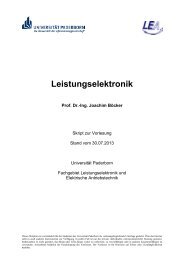

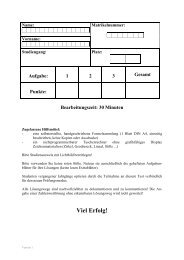
![[ ] Ï - Fachgebiet Leistungselektronik und Elektrische Antriebstechnik](https://img.yumpu.com/51151382/1/184x260/-i-fachgebiet-leistungselektronik-und-elektrische-antriebstechnik.jpg?quality=85)
